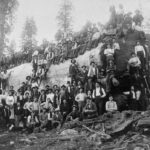
The log, with a staggering diameter of 26 feet, dwarfed the team and their equipment, including a group of horses perched atop it for scale. This striking image showcased the monumental size of the Sequoias and the immense effort required to fell and process such giant trees in an era of rudimentary logging technology.
The California Sequoias, renowned for their towering heights and immense girths, were highly sought after during the early 20th century. Logging teams like Joe Clark’s operated in California’s dense forests, providing timber that fueled a rapidly industrializing nation. The wood was essential for building homes, crafting furniture, and supporting infrastructure projects, making these ancient trees a cornerstone of the American economy at the time.
However, the photograph also highlights the duality of human ambition and environmental cost. While the colossal trees symbolized natural splendor, their removal marked a turning point in the transformation of California’s forests. By the early 1900s, logging operations had begun to alter the pristine landscapes, sparking conversations about conservation and the need to balance industrial growth with environmental preservation.
This image stands as a testament to the human spirit of innovation and determination, as well as a reminder of the importance of protecting our natural heritage. “In every tree lies a story—not just of the past it has witnessed, but of the future we choose to shape.”










Leave a Reply